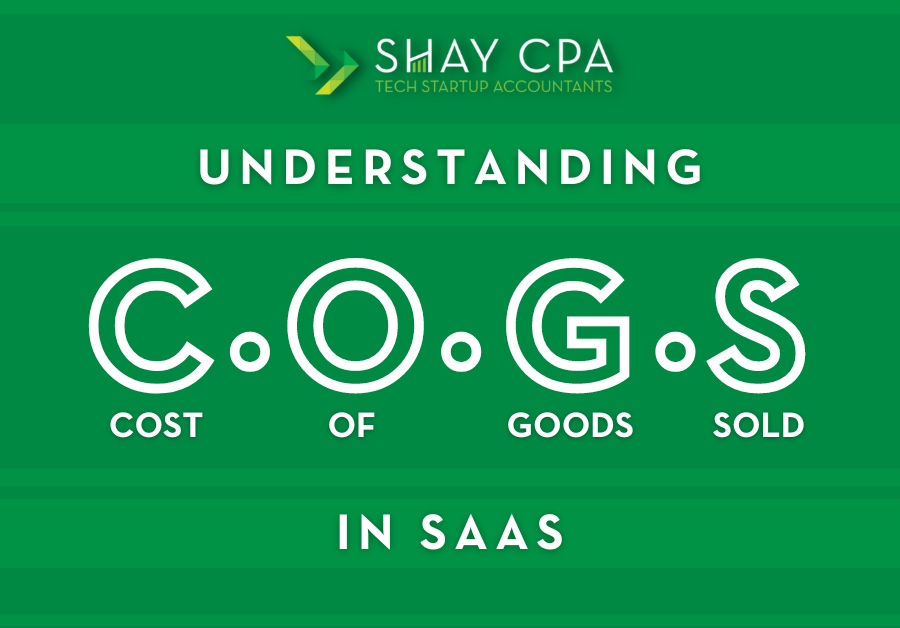Unlike e-commerce businesses and manufacturers, software-as-a-service (SaaS) companies usually don’t have inventory in the traditional sense. Instead, modern software is delivered to customers through the rental of servers and cloud storage services, where the software lives and “computes.”
When the end user/customer is using your product, what they’re actually accessing is an instance of your software that lives in a server and that can, in real-time, deliver your service. Some examples of services that do this today are Amazon Web Servers (AWS), Google Cloud, and Microsoft Azure.
Like any company, though, SaaS providers need to monitor the money coming in and going out. And that means calculating the cost of goods sold (COGS). This is easier said than done. When it comes to calculating these costs (e.g., rack space, servers), we often find that founders have difficulty distinguishing their operating expenses from their COGS.
If you’re not precisely sure of the difference, we’re here to help. First, let’s go over definitions.
Your quick-start glossary
To make this conversation easier, it’s helpful to understand certain terminology. Here are your definitions:
- Revenue Per Unit or Software: This is the price per license you charge your customer.
- Cost of Goods Sold: This is the per-unit cost to your startup of delivering one license to your customer.
- Gross Profit: This is your revenue minus the COGS. It’s commonly known as your gross profit margin.
- Operating Expenses: These are below-the-line (i.e., below the gross profit line) expenses. Typically, these fall into three main buckets: general & administrative (G&A), sales & marketing (S&M), and research & development (R&D).
- Net Income: This is your gross profit minus your operating expenses. Your net income is commonly known as the bottom line.
Why COGS matters in SaaS
Now, let’s refocus on COGS. The importance of calculating your COGS correctly drives your gross profit margin. Having a higher gross profit margin means that the revenue generated is significantly higher than the cost per unit. This can often mean that you can have a differentiated product strategy that isn’t dependent on high-volume sales.
For a lower gross margin business, you may have a cost leadership product strategy. In this case, you’ll need to focus on bringing in as many customers as possible (high volume). Remember, for your bottom line (gross profit minus operating expenses) to be positive, you’ll need to have a high enough gross profit margin to cover your operating expenses.
For most early-stage technology companies, this is usually not the case. Their operating expenses are often significantly higher and the company is running at a loss. In other words, gross profit minus operating expenses is usually negative. This loss is being covered by the various rounds of investor capital getting pumped into the business to fund company growth and R&D.
With that being the case, investors are laser-focused on your gross profit calculation.
Calculating gross profit based on COGS
Here’s a step-by-step guide to help you calculate this measure.
Step one: figure out your COGS
Identify the vendors and costs that make up your cost of goods. For SAAS companies, we usually see them in the following buckets:
- Server/Hosting Services: Examples would be AWS, Google Cloud, Microsoft Azure, etc.
- Engineering Salaries: You may want to allocate a portion of engineering salaries to COGS. This would include any full-time/part-time employees that directly contribute toward the software product. Very often, an overhead allocation may need to be calculated in order to split the salaries between COGS and R&D. This bucket could also include one-off professional services (non-recurring revenue [NRR]) that are very common in Enterprise SAAS projects.
- Customer Success Salaries: The Customer Success team is usually on the front lines when it comes to onboarding, implementations, and troubleshooting issues. As a result, it usually makes sense to allocate a majority of their salaries towards COGS.
- Third-Party Software: This is software like GitHub repository services, developer tools, and tools that are directly related to revenue generation.
Step two: figure out allocations
You will need to come up with a methodology to allocate the above costs to COGS. This is usually done either based on revenue (the number of licenses sold in a particular month) or based on the number of hours allocated per month.
After a methodology is chosen, it’s important to be consistent and have a process to identify these costs on an ongoing basis. Without a proper methodology, gross margins will wildly fluctuate and it will be difficult for management teams and investors to gauge how the business is performing.
Step three: create a system
Make these adjustments in the accounting system and then analyze the results with projections and the previous month’s data. Your accounting team will need to be involved to record adjustments to COGS on a monthly basis. They will also need to help the management team to analyze and review gross profit margins as part of a monthly process each time financial statements are generated. (Hint: our accountants can help with all of this.)
The level of automation that can be applied to this process is dependent on how sophisticated your allocation method is and the way expenses are paid (i.e, prepaid or paid on a monthly basis).
There’s a fine line here. Get too complicated and you run the risk of having delayed financial reporting. Conversely, not paying enough attention to this area will lead to COGS calculations that are misaligned across periods.
If all of this sounds intensive, it’s because it is. It’s important for founders to balance the cost/benefit of investing time and energy in this department. For that reason, many startups benefit from working with outsourced accounting teams who understand the nuances of tech company accounting.
Our firm, for example, loves to get into the nitty gritty of calculating COGS and gross margins. Contact us today to learn more.

